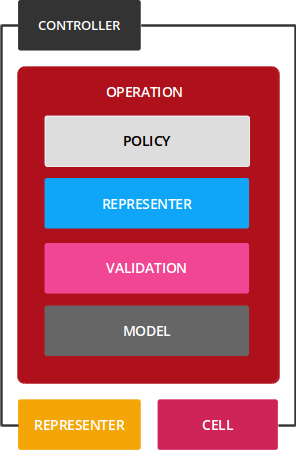Trailblazer provides new high-level abstractions for Ruby frameworks. It gently enforces encapsulation, an intuitive code structure and approaches the modeling of complex business workflows with a functional mind-set.
This document discusses Trailblazer 2.1. An overview about the additions are on our website.
We're working on several new example applications!
- Refactoring to Trailblazer discusses how the cfp-app is converted into a TRB app.
- BPMN and workflows shows in-detail how the new 2.1 features in Trailblazer are used.
The 1.x documentation is here.
- All business logic is encapsulated in operations (service objects).
- Controllers instantly delegate to an operation. No business code in controllers, only HTTP-specific logic.
- Models are persistence-only and solely define associations and scopes. No business code is to be found here. No validations, no callbacks.
- The presentation layer offers optional view models (Cells) and representers for document APIs.
- More complex business flows and life-cycles are modeled using workflows.
Want code? Jump right here!
While Trailblazer offers you abstraction layers for all aspects of Ruby On Rails, it does not missionize you. Wherever you want, you may fall back to the "Rails Way" with fat models, monolithic controllers, global helpers, etc. This is not a bad thing, but allows you to step-wise introduce Trailblazer's encapsulation in your app without having to rewrite it.
Trailblazer is all about structure. It helps re-organize existing code into smaller components where different concerns are handled in separated classes.
Again, you can pick which layers you want. Trailblazer doesn't impose technical implementations, it offers mature solutions for recurring problems in all types of Rails applications.
Trailblazer is no "complex web of objects and indirection". It solves many problems that have been around for years with a cleanly layered architecture. Only use what you like. And that's the bottom line.
Trailblazer offers you a new, more intuitive file layout in applications.
app
├── concepts
│ ├── song
│ │ ├── operation
│ │ │ ├── create.rb
│ │ │ ├── update.rb
│ │ ├── contract
│ │ │ ├── create.rb
│ │ │ ├── update.rb
│ │ ├── cell
│ │ │ ├── show.rb
│ │ │ ├── index.rb
│ │ ├── view
│ │ │ ├── show.haml
│ │ │ ├── index.rb
│ │ │ ├── song.css.sass
Instead of grouping by technology, classes and views are structured by concept, and then by technology. A concept can relate to a model, or can be a completely abstract concern such as invoicing.
Within a concept, you can have any level of nesting. For example, invoicing/pdf/ could be one.
Trailblazer extends the conventional MVC stack in Rails. Keep in mind that adding layers doesn't necessarily mean adding more code and complexity.
The opposite is the case: Controller, view and model become lean endpoints for HTTP, rendering and persistence. Redundant code gets eliminated by putting very little application code into the right layer.
Trailblazer uses Rails routing to map URLs to controllers, because it works.
Rails.application.routes.draw do
resources :songs
endControllers are lean endpoints for HTTP. They do not contain any business logic. Actions immediately dispatch to an operation.
class SongsController < ApplicationController
def create
run Song::Create # Song::Create is an operation class.
end
endThe #run method invokes the operation. It allows you to run a conditional block of logic if the operation was successful.
class SongsController < ApplicationController
def create
run Song::Create do |op|
return redirect_to(song_path op.model) # success!
end
render :new # invalid. re-render form.
end
endAgain, the controller only dispatchs to the operation and handles successful/invalid processing on the HTTP level. For instance by redirecting, setting flash messages, or signing in a user.
Operations encapsulate business logic and are the heart of a Trailblazer architecture.
The bare bones operation without any Trailblazery is implemented in the trailblazer-operation gem and can be used without our stack.
Operations don't know about HTTP or the environment. You could use an operation in Rails, Hanami, or Roda, it wouldn't know.
An operation is not just a monolithic replacement for your business code. It's a simple orchestrator between the form objects, models, your business code and all other layers needed to get the job done.
class Song::Create < Trailblazer::Operation
step :model
step :validate
def model(ctx, **)
# do whatever you feel like.
ctx[:model] = Song.new
end
def validate(ctx, params:, **)
# ..
end
endOperations define the flow of their logic using the DSL and implement the particular steps with pure Ruby.
You cannot instantiate them per design. The only way to invoke them is call.
Song::Create.(params: {whatever: "goes", in: "here"})Their high degree of encapsulation makes them a replacement for test factories, too.
Models for persistence can be implemented using any ORM you fancy, for instance ActiveRecord or Datamapper.
In Trailblazer, models are completely empty. They solely contain associations and finders. No business logic is allowed in models.
class Song < ActiveRecord::Base
belongs_to :thing
scope :latest, lambda { all.limit(9).order("id DESC") }
endOnly operations and views/cells can access models directly.
In Trailblazer, you only have operation unit tests and integration smoke tests to test the operation/controller wiring.
Operations completely replace the need for leaky factories.
describe Song::Update do
let(:song) { Song::Create.(song: {body: "[That](http://trailblazer.to)!"}) }
endOperations are a great way to clean up controllers and models. However, Trailblazer goes further and provides an approach to model entire life-cycles of business objects, such as "a song" or "the root user" using workflow (pro feature). Also, you don't have to use the DSL but can use the editor instead (cool for more complex, long-running flows). Here comes a sample screenshot.
The obvious needs to be in your Gemfile.
gem "trailblazer"
gem "trailblazer-rails" # if you are in rails.
gem "trailblazer-cells"Cells is not required per default! Add it if you use it, which is highly recommended.


